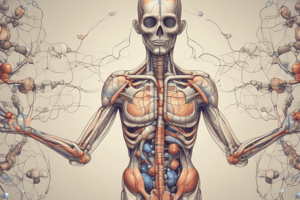Podcast
Questions and Answers
What is a common central nervous system effect associated with strong opioid agonists?
What is a common central nervous system effect associated with strong opioid agonists?
- Increased gastrointestinal motility
- Hypertension
- Increased histamine release
- Respiratory depression (correct)
Which cardiovascular effect can occur due to opioid agonism?
Which cardiovascular effect can occur due to opioid agonism?
- Bradycardia caused via CNS (correct)
- Vasodilation and increased blood pressure
- Tachycardia in all patients
- Increased cardiac output
What gastrointestinal effect is commonly associated with the use of opioids?
What gastrointestinal effect is commonly associated with the use of opioids?
- Decreased motility leading to constipation (correct)
- Enhanced appetite
- Nausea with no vomiting
- Increased risk of diarrhea
Which of the following is classified as a strong opioid agonist?
Which of the following is classified as a strong opioid agonist?
What happens to tolerance levels as opioid use continues over time?
What happens to tolerance levels as opioid use continues over time?
Which type of opioid receptor is primarily associated with euphoria and has the highest effect from endorphins?
Which type of opioid receptor is primarily associated with euphoria and has the highest effect from endorphins?
What is a common physiological consequence of chronic opioid use?
What is a common physiological consequence of chronic opioid use?
Which opioid receptor is most likely to induce dysphoria and has the strongest effect from dynorphins?
Which opioid receptor is most likely to induce dysphoria and has the strongest effect from dynorphins?
What effect does opioid agonist activation primarily have on cardiovascular function?
What effect does opioid agonist activation primarily have on cardiovascular function?
Which mechanism is NOT commonly associated with the adaptations to opioid agonist activation?
Which mechanism is NOT commonly associated with the adaptations to opioid agonist activation?
Which of the following best describes 'withdrawal' in the context of opioid dependence?
Which of the following best describes 'withdrawal' in the context of opioid dependence?
Which statement about tolerance and dependence is accurate?
Which statement about tolerance and dependence is accurate?
What effect do opioids have on gastrointestinal transit?
What effect do opioids have on gastrointestinal transit?
Which of the following accurately describes the central nervous system effects of µ agonists?
Which of the following accurately describes the central nervous system effects of µ agonists?
What is the primary consequence of opioid-induced respiratory depression?
What is the primary consequence of opioid-induced respiratory depression?
Which of the following pain types tends to respond poorly to opioid treatment?
Which of the following pain types tends to respond poorly to opioid treatment?
What factors influence the degree of respiratory depression caused by opioid agonists?
What factors influence the degree of respiratory depression caused by opioid agonists?
Which class of opioids is primarily associated with the generation of euphoric sensations?
Which class of opioids is primarily associated with the generation of euphoric sensations?
What is a common risk factor for developing opioid dependence?
What is a common risk factor for developing opioid dependence?
What mechanism contributes to the experience of addiction after opioid withdrawal?
What mechanism contributes to the experience of addiction after opioid withdrawal?
What is the primary role of endogenous opioids during the fight or flight response?
What is the primary role of endogenous opioids during the fight or flight response?
Study Notes
Opioid Receptors and Their Effects
- µ (Mu) receptors: Associated with euphoria, analgesia, decreased respiration, sedation, and reduced gastrointestinal transit. Tolerance and dependence can develop.
- δ (Delta) receptors: Primarily linked to euphoria and analgesia. Develops tolerance but has less widespread effects compared to µ.
- κ (Kappa) receptors: Induces dysphoria, sedation, and psychotomimetic effects with increased diuresis and decreased GI transit. Enkephalins activate these receptors strongly.
Mechanisms of Action
- Opioid agonist activation leads to:
- Decreased adenylyl cyclase activity (post-synaptic inhibition)
- Increased K+ channel activity (post-synaptic inhibition)
- Decreased Ca+2 channel activity (pre-synaptic inhibition)
- Adaptations from chronic opioid exposure result in tolerance, dependence, and withdrawal.
Definitions
- Tolerance: Reduced drug efficacy with repeated use.
- Dependence: Changes resulting in altered homeostatic balance leading to withdrawal syndrome.
- Withdrawal: Physical and psychological symptoms from sudden drug cessation.
- Addiction: Compulsive drug use characterized by an overwhelming focus on procurement and consumption.
Tolerance and Dependence Insights
- Present in all patients; does not predict addiction or abuse risk.
- Approximately 23% of individuals trying heroin may develop dependence, with 21-22% misuse rates.
- Addiction occurs in a small percentage and typically follows prolonged exposure, marked by distinct epigenetic changes.
Non-CNS Effects of Opioids
- Cardiovascular: May cause bradycardia and hypotension; meperidine can cause tachycardia due to antimuscarinic effects.
- Gastrointestinal: Promotes constipation by reducing motility.
- Renal: Leads to depressed function and antidiuresis.
- Uterine effects: May prolong labor.
- Pruritus: Histamine release can occur with parenteral administration.
Opioid Classification
- Strong Opioid Agonists: Morphine, Hydromorphone, Oxymorphone, Heroin, Methadone, Meperidine, Fentanyl.
- Weak Opioid Agonists: Codeine, Oxycodone, Hydrocodone, Diphenoxylate, Loperamide.
Tolerance Characteristics
- High tolerance develops for analgesia, euphoria/dysphoria, sedation, and respiratory depression.
- Moderate tolerance for cardiovascular bradycardia effects.
- Little to no tolerance for miosis and constipation.
- Crossover tolerance can occur but is usually incomplete, leading to variability when switching opioids.
Mechanism of Reward and Addiction
- Activation of the mesolimbic dopamine pathway is linked to euphoria. This pathway connects the ventral tegmental area to the nucleus accumbens, influencing pleasure response.
- Receptors for opioids, including κ and δ, are concentrated in the nucleus accumbens.
Analgesic Properties
- Endogenous opioids enhance pain tolerance, crucial in protective mechanisms during stress.
- Nociceptive pain responds well to opioids, while neuropathic pain may need higher doses or alternative treatments.
Results of Opioid Agonism
- Central nervous system effects include sensory and emotional analgesia, euphoria, sedation, and respiratory depression.
- Respiratory depression can occur even at therapeutic doses and is influenced by sensory input levels.
Therapeutic Uses
- Opioids are used for moderate to severe pain relief, particularly in postoperative care and terminal illness, often combined with other agents for effective management.
Studying That Suits You
Use AI to generate personalized quizzes and flashcards to suit your learning preferences.
Related Documents
Description
Test your knowledge on opioid receptors, their effects, and the mechanisms of action involved. This quiz covers the roles of µ, δ, and κ receptors, as well as concepts like tolerance and dependence. Perfect for students studying pharmacology or neuroscience.




